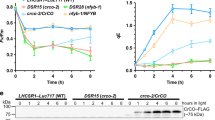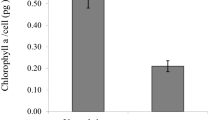Abstract
In the green unicellular alga Chlamydomonas reinhardtii, as in higher plants, the expression of the genes encoding the chlorophyll a/b-binding (CAB) polypeptides associated with photosystem I (PSI) and photosystem II (PSII) is regulated by endogenous (circadian clock) and exogenous signals (light and temperature). The circadian clock ensures that the oscillation in the levels of the different cab mRNAs is continuously kept in phase with light/dark (LD) cycles and is maximal by the middle of the day. On the other hand, light controls the amplitude of the oscillations. We report here the cloning and characterization of the C. reinhardtii LI818 gene, which identifies a CAB-related polypeptide and whose expression is regulated quite differently from the cabI/II genes. We show: (1) that in LD synchronized Chlamydomonas cells LI818 mRNA accumulation is subject to dual regulation that involves separable regulation by light and an endogenous oscillator; (2) that LI818 mRNA is fully expressed several hours before the cab I/II mRNAs and that the latter accumulate concomitantly; (3) that blocking the electron flow through PSII using DCMU prevents cells from accumulating cab I/II mRNAs but not LI818 mRNA and (4) that the accumulation of LI818 mRNA is abolished by blocking cytoplasmic protein synthesis, suggesting that these regulatory mechanisms are mediated by labile proteins.
Similar content being viewed by others
References
AdamskaI, KloppstechK: The role of early light-induced proteins (ELIPS) during light stress. In: BakerNR, BowyerJR (eds) Photoinhibition of Photosynthesis, pp. 205–219. Bios Scientific, Oxford (1992).
AndersonSL, KaySA: Functional dissection of circadian clock- and phytochrome-regulated transcription of the Arabidopsis CAB2 gene. Proc Natl Acad Sci USA 92: 1500–1504 (1995).
BakerE, LiggitP: Accelerated poly(A) loss and mRNA stabilization are independent effects of protein synthesis inhibition on α-tubulin mRNA in Chlamydomonas. Nucl Acids Res 21: 2237–2246 (1993).
BassiR, SoenS, FrankG, ZuberH, RochaixJD: Characterization of chlorophyll-a/b binding proteins of photosystem I from Chlamydomonas reinhardtii. J Biol Chem 267: 25714–25721 (1992).
BassiR, WollmanFA: The chlorophyll-a/b binding proteins of photosystem II in Chlamydomonas reinhardtii. Planta 183: 423–433 (1992).
BuchheimMA, TurmelM, ZimmerEA, ChapmanRL: Phylogeny of Chlamydomonas (Chlorophyta) based on cladistic analysis of nuclear 18S rRNA sequence data. J Phycol 26: 689–699 (1990).
CoutureM, ChamberlandH, St-PierreB, LafontaineJ, GuertinM: Nuclear genes encoding chloroplast hemoglobins in the unicellular green alga Chlamydomonas eugametos. Mol Gen Genet 243: 185–197 (1994).
DunlapJC: Closely watched clocks: molecular analysis of circadian rhythms in Neurospora crassa. Trends Genet 6: 159–165 (1990).
GagnéG, GuertinM: The early genetic response to light in the green unicellular alga Chlamydomonas eugametos grown under light/dark cycles involves genes that represent direct responses to light and photosynthesis. Plant Mol Biol 18: 429–445 (1992).
GaleEF, CundliffeE, ReynoldsPE, RichmondMH, WaringMJ: Antibiotic inhibitors of ribosome function. In: LtdJWS (ed) The Molecular Basis of Antibiotic Action, pp. 278–366. Wiley-Interscience, London (1972).
GiulianoG, HoffmanNE, KoK, ScolnikPA, CashmoreAR: A light-entrained circadian clock controls transcription of several plant genes. EMBO J 7: 3635–3642 (1988).
GreenBR, KühlbrandtW: Sequence conservation of light-harvesting and stress-response proteins in relation to the three-dimensional molecular structure of LHCII. Photosynth Res 44: 139–148 (1995).
GrimmB, KruseE, KloppstechK: Transiently expressed early light-inducible thylakoid proteins share transmembrane domains with light-harvesting chlorophyll binding proteins. Plant Mol Biol 13: 583–593 (1989).
HarrisE: The Chlamydomonas Sourcebook. Academic Press, San Diego, CA (1989).
HwangS, HerrinDL: Characterization of a cDNA encoding the 20-kDa photosystem I light-harvesting polypeptide of Chlamydomonas reinhardtii. Curr Genet 23: 512–517 (1993).
HwangS, HerrinDL: Control of Lhcal * 1 gene transcription by the circadian clock in Chamydomonas reinhardtii. Plant Mol Biol 26: 557–569 (1994).
ImbaultP, WittemerC, JohanningmeierU, JacobsJD, HowellSH: Structure of the Chlamydomonas reinhardtii cabII-I gene encoding a chlorophyll a/b-binding protein. Gene 73: 397–407 (1988).
Jacobshagen S, Johnson CH: Circadian rhythms of gene expression in Chlamydomonas reinhardtii: circadian cycling of mRNA abundances of cab II, and possibly of beta-tubulin and cytochrome c. Eur J Cell Biol 64: 142–152.
KeegstraK, OlsenLJ, ThegSM: Chloroplastic precursors and their transport across the envelope membranes. Annu Rev Plant Physiol Plant Mol Biol 40: 471–501 (1989).
KellmannJW, MerforthN, WieseM, PicherskyE, PiechullaB: Concerted circadian oscillations in transcripts levels of nineteen Lha/b (Lhc) genes in Lycopersicon esculentum (tomato). Mol Gen Genet 237: 439–448 (1993).
KindleKL: Expression of a gene for a light-harvesting chlorophyll a/b-binding protein in Chlamydomonas reinhardtii: effect of light and acetate. Plant Mol Biol 9: 547–563 (1987).
KühlbrandtW, WangDN, FujiyoshiY: Atomic model of plant light-harvesting complex by electron crystallography. Nature 367: 614–621 (1994).
LersA, LevyH, ZamirA: Co-regulation of a gene homologous to early light-induced genes in higher plants and β-carotene biosynthesis in the alga Dunaliella bardawil. J Biol Chem 266: 13698–13705 (1991).
McAteerM, DonnanL, JohnPCL: The timing of division in Chlamydomonas. New Phytol 99: 41–56 (1985).
MeyerH, ThienelU, PiechullaB: Molecular characterization of the diurnal/circadian expression of the chlorophyll a/b-binding proteins in leaves of tomato and other dicotyledonous and monocotyledonous plant species. Planta 180: 5–15 (1989).
MillarAJ, KaySA: Circadian control of cab gene transcription and mRNA accumulation in Arabidopsis. Plant Cell 3: 541–550 (1991).
NagyF, KaySA, ChuaNH: A circadian clock regulates transcription of the wheat Lhc-1 gene. Genes Devel 2: 376–382 (1988).
NikaidoS, LockeCR, WeeksDP: Automated sampling and RNA isolation at room temperature for measurements of circadian rhythms in Chlamydomonas reinhardtii. Plant Mol Biol 26: 275–284 (1994).
PaulsenH, BogoradL: Diurnal and circadian rhythms in the accumulation and synthesis of mRNA for the light-harvesting chlorophyll a/b-binding protein in tobacco. Plant Physiol 88: 1104–1109 (1988).
ShepherdHS, LedoigtG, HowellSH: Regulation of light-harvesting chlorophyll-binding protein (LHCP) mRNA accumulation during the cell cycle in Chlamydomonas reinhardtii. Cell 32: 99–107 (1983).
SpudichJL, SagerR: Regulation of the Chlamydomonas cell cycle by light and dark. J Cell Biol 85: 136–145 (1980).
TaylorWC: Transcriptional regulation by a circadian rhythm. Plant Cell 1: 259–264 (1989).
TurmelM, BellemareG, LemieuxC: Physical mapping of differences between the chloroplast DNAs of the interfertile algae Chlamydomonas eugametos and Chlamydomonas moewusii. Curr Genet 11: 543–552 (1987).
TurmelM, GutellRR, MercierJP, OtisC, LemieuxC: Analysis of the chloroplast large subunit ribosomal RNA gene from 17 Chlamydomonas taxa: three internal transcribed spacers and 12 group I intron insertion sites. J Mol Biol 232: 446–467 (1993).
WedelN, KleinR, LjungbergU, AnderssonB, HerrmannRG: The single-copy gene psbS codes for a phylogenetically intriguing 22 kDa polypeptide of photosystem II. FEBS Lett 314: 61–66 (1992).
Author information
Authors and Affiliations
Rights and permissions
About this article
Cite this article
Savard, F., Richard, C. & Guertin, M. The Chlamydomonas reinhardtii LI818 gene represents a distant relative of the cabI/II genes that is regulated during the cell cycle and in response to illumination. Plant Mol Biol 32, 461–473 (1996). https://doi.org/10.1007/BF00019098
Received:
Accepted:
Issue Date:
DOI: https://doi.org/10.1007/BF00019098




